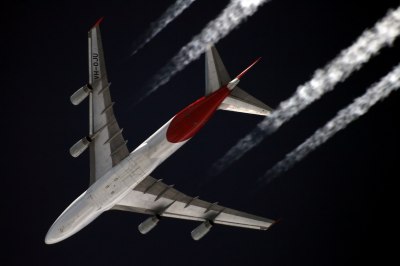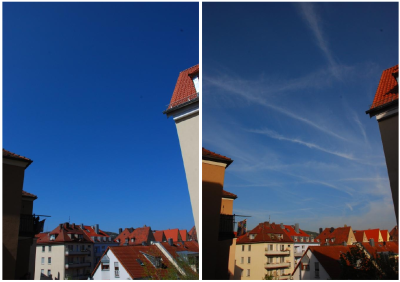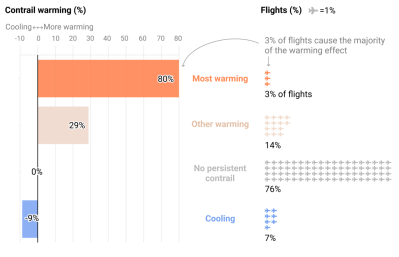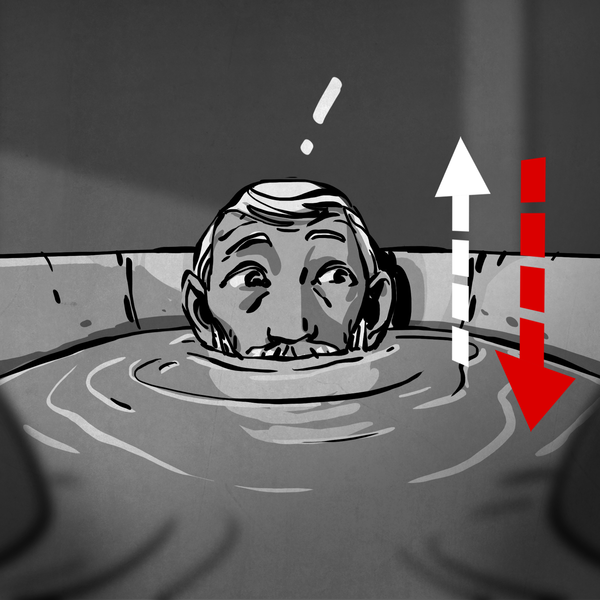Most of us first spot them as children—the white lines in the blue sky that are the telltale sign of a flight overhead. Contrails are an instant visual reminder of air travel, and a source of much controversy in recent decades. Put aside the overblown conspiracies, though, and there are some genuine scientific concerns to explore.
See, those white streaks planes leave in the sky aren’t just eye-catching. It seems they may also be having a notable impact on our climate. Recent research shows their warming effect is comparable to the impact of aviation’s CO2 emissions. The question is then simple—how do we stop these icy lines from heating our precious Earth?
But How?

The name contrails is a portmanteau of “condensation trails,” which tells you everything you need to know. Those white streaks form when aircraft fly through cold, humid areas of the atmosphere. They come about when water vapor mixes with tiny particles of soot and sulfur in the aircraft’s exhaust, which act as nucleation points for forming water droplets. These then tend to freeze in low temperature conditions, creating icy particles behind the aircraft. The result? The telltale trail in the sky.
Due to the chemical vagaries of combustion, aircraft exhaust pretty much contains all the ingredients for contrail production—primarily water vapor and tiny particulates. However, those alone aren’t enough to produce a bright and lingering contrail. Some contrails may only last a few seconds, or maybe a few minutes, in moderately cool zones of the atmosphere. However, in places where it gets particularly cold and humid, it’s possible for an aircraft to leave contrails that last for hours, slowly spreading out until they become many kilometers wide. Under these conditions, they functionally increase the level of cloud cover in the atmosphere.
The Problem
Unfortunately, contrails aren’t just pretty lines in the sky. Scientists have found they also have an impact on the climate—and not in the direction we’d like. Unfortunately, contrails tend to have a warming effect. While they increase the amount of sunlight reflected away from Earth, they ultimate trap more heat in the atmosphere than they bounce away.

It might sound like a minor thing, but the science suggests their warming impact is likely larger than that of fossil fuel emissions from global aviation operations. One study performed in 2018 suggested that contrails are doing more to heat up the Earth than all the CO2 emitted by aviation since 1940. The science is clear – these artificial clouds are a serious climate concern.
There is hope for tackling this icy problem, however. As most of us have noticed, not every plane leaves a bright, long lasting contrail. That’s because atmospheric conditions have to be within a certain range to produce them. Fly in warmer, less humid air, and your contrails won’t last as long—nor do as much harm to the climate.
As it turns out, less than 3% of global flights generate 80% of contrail warming. The effect is particularly pronounced in regions like North America, Europe, and the North Atlantic, where high-altitude flights are common. Night flights also cause the most warming, because the clouds are just trapping heat. Daytime flights create less damaging contrails because they reflect some sunlight to offset the heat they’re trapping on Earth.
The good news is that relatively simple solutions exist. By making minor adjustments to flight paths – climbing or descending slightly to avoid the cold, humid atmospheric layers where contrails form – airlines can significantly reduce their climate impact. In a 2023 trial, tests by American Airlines and Google showed that it was possible to cut contrail formation by 54% with only a 2% increase in fuel use. With only some flights having to adjust their routes to reduce contrails, the effect could be as little as an 0.3% increase in fuel burn across an airline’s fleet. In fact, one study suggests that the benefits of producing less contrails would be 100 times greater than the penalty of added greenhouse gas emissions from the greater fuel burn. Cost-wise, estimates suggest avoiding contrails would add just €3.90 to a Paris-New York ticket or €1.20 to a Barcelona-Berlin flight.

The aviation industry now faces a clear opportunity: by targeting the small number of flights causing most contrail warming, they could make a major dent in their climate impact at minimal cost. With appropriate weather forecasting and flight planning, contrail avoidance could be one of aviation’s most cost-effective climate solutions.
It’s not an instant solution—there is still a great deal of work to be done before this is a routine practice in the industry. Ultimately, more fuel burn will still cost airlines money, as will the administrative overhead of predicting pro-contrail conditions and tasking aircraft to avoid them. Regardless, addressing contrails offers a smart, immediate way to reduce aviation’s contribution to global warming. The science is solid, the solutions are available, and the costs are theoretically manageable. The next step is putting this knowledge into action—the question remains as to which airlines lead the charge.
















After the 9/11 attacks on the USA there was s study done that concluded that the temperature went up due to several weeks of no contrails. Follow the science. https://www.sciencedaily.com/releases/2002/08/020808075457.htm
Yes but no.
The article mentions the DIFFERENCE between daytime and nighttime temp went up.
Cooler day and warmer night with contrails = smaller difference.
Hotter day and cooler night without contrails = larger difference.
Also, over 3 days, not several weeks.
Unless you meant a different article?
That’s not what the article says:
“The diurnal temperature range is the difference between the nighttime low temperature and the daytime high temperature, usually for a given day.”
Basically, the day-to-night swing increased, not the average temperature.
Back when commercial airlines started to fly jet aircraft, the big concern was that the contrails would block the sun and cause cooling, particularly in “fly-over country,” the USA’s farm belt in the middle of the country. Less sun might have meant lower crop yields. Current “research” indicates the contrails cause heating. Really? Let’s see what peer-reviewed and unbiased studies have to say in a few years, or a decade.
Contrails Are A Hot Topic, But What Is The Relevance?
If you missed the 8 mentions in the article: Climate change and to an extrapolated degree the slowing down of the Atlantic Meridional Overturning Circulation. Not important anyway. Needs to get way worse for people to start believing it. Ironically less ocean circulation will lead to cooling in the north and worse heat droughts around the equator.
Much ado about nothing. You cant undo climate change in any meaningful way quick enough to reverse course , not in a system that runs on money. Contrails in the sky are the least of anyone’s issues. What’s amusing is the complaints about increased warming from ships that now burn cleaner fuel that doesnt produce visible emissions which is estimated to make the problem worse than it helps with less CO2.
“What’s amusing is something not relevant to the article that I just want to post because I’m a climate skeptic” :facepalm:
Reducing contrails looks to increase costs. That’s going to go over well.
Hit exactly on the head.
Customers and certainly corporations DGAF about reducing emissions. “Take our flight it’s better for the environment but doesn’t leave when you need it to and actually costs a bit more” is a really tough sell. Sorry to be cynical.
Maybe the aviation field will have an EV revolution.
Hahaha good one
I’m so thankful for that. The Paris agreement is detrimental to American citizens. If other countries feel the need to destroy their economy over a phony problem based on bad science and more about politics, they are welcome to do so.
+1
Amen.
No doubt you enjoy a good Trolling session, but just in case you really are that ignorant, have a read of this:
https://royalsociety.org/news-resources/projects/climate-change-evidence-causes/basics-of-climate-change/#:~:text=Human%20activities%20are%20changing%20the,the%20influence%20of%20human%20activities.
Wait what? We’re doing chemtrails now? What % of heat do contrails “trap” compared to normal cloud cover? Has the increased albedo been accounted for? Maybe we should put up some copper pipes to disperse them!
Obligatory XKCD….
https://xkcd.com/966/
yes, it is called “vaping”
depends, see article above
yes
this but unironically, anti-science mongoloids like you should be stripped of your rights legally and through due process and sent to a walled off city in west texas where you can poison yourselves with colloidal blue and worship effigies of the orange calf.
no my computer model is better. You need to give ME the money now and ill fly around the world telling you lower class citizens how bad contrails are
Let’s all fly our private jets to Davos to talk about it. If the Paris Accords were actually about solutions and not just punishing the western economies while ignoring the world’s largest producers of pollution we might be more inclined to participate.
There’s a case to be made that increased aerosol pollution during WWII caused a slight warming but I say bring it.
Contrails. I personally don’t care if it gets warmer and if I were in a position to make policy the policy would be “don’t care.” Warmer is more gooder. More carbon dioxide means more fuel for plants which means more oxygen for me. Rise oceans, rise!
In the Paris Accords China promised to start…. something…. thirty years in the future. I don’t put much stock in Accords. They’re the time-share of international relations.
“an 0.3% increase” Really? An?
Is that supposed to be sarcasm?
In case not, you should look up the collapse of the collapse of the Atlantic current system: https://oceanographicmagazine.com/news/amoc-atlantic-tipping-point-keeping-climate-stable-greatly-underestimated/
Where is the Edit button?
It’s right next to the Sip a Dee release lever.
LOL edit button. You’re funny.
I think Lewis is Aussie so he can pronounce that as “an oh point three” increase. Still valid
There is no point in trying to stop global warming; doing so is evolutionarily unfavorable in the short term for any nation that tries. Living organisms only stop reproducing and consuming resources when said resources are depleted, and humans are no exception. At this point we should be planning for a warmer future (i.e. developing the Arctic and Antarctic regions) rather than pretending we can reverse entropy.
That would be a disaster as humanity doesn’t really have a clue about the complex interactions that create all those previously stable but soon to be extinct if we can’t transplant them ecosystems. Some climate change isn’t a problem, life is adaptable. So you could do somewhat as you suggest if the rate is slow enough – as that both gives natural selection a chance and gives the humans trying to keep the ecosystem functional enough time to study how things are going wrong and then react.
The ‘oh don’t bother just burn all you want as that is good for your economy right now’ argument just doesn’t fly, as that short term gain is probably better measured in months than years at this point. For one case in point the extreme weather that is already becoming more and more frequent has huge costs that go with it. Disaster recovery and trying to restart the local economy again and again, while building more expensive constructions and spending fortunes hardening the infranstructure in the probably futile hope they will survive future weather functionally despite the ever worsening conditions is just ruinously expensive. So making that problem actively worse rather than than working towards reducing it is about as stupid as shooting yourself in the leg so you can have a fancy prosthetic one that lets you run faster for the short period the battery lasts, along with a continuos maintance bill on this very high tech and not self repairing limb..
The argument is not about which hypothetical scenario would be better, but that humanity as an aggregate is basically a dumb natural phenomena like a hurricane and isn’t steerable or fixable. Only a risk to be mitigated in a few localized and specific zones
Yeah, it’s this. Without exception, we behave like yeast in a dish of sugar water. Better to take this into account when planning for the future, than to try to teach the yeast to be responsible.
If we really were that bad and incapable of rational and considered actions we would still be fighting wars across every border in Europe every other year, the USA might well have become a colony again or the other way survived or avoided that fight but decided it would rather like Mexico and Canada. So if no effort towards peaceful co-existance was made…
The argument it isn’t worth trying just doesn’t work – the only thing that is certain is the outcome if you don’t bother, and that is pretty terrible. So it is worth putting in the effort even though it may prove insufficient. And as it is actually to our benefit to control our environmental impact, thus ensuring we remain with an environment capable of supporting us…
Heck now the benefit to doing so is in many cases going to be a rather swift payout. All the individual little details like these contrail, concepts to cut down micro plastics etc may or may not be impactful on their own, or even beneficial at all – study is always needed. But you have to try, and educate the population that doesn’t already understand how it is in their own benefit to fix these flaws (well if they are not one foot in the grave already) and once the evidence is ready which methods actually help. As seen with things like DDT being banned, and the algal blooms, pea soupers, lead in petrol etc…
This comment advocates for the same approach to life as a malignant tumor
I’m not advocating, I’m observing. If it looks like a duck, flies like a duck, quacks like one, etc…
Thankfully you can get a tumor removed. You can also educate others so they are less likely to expose themselves to situations, or live a lifestyle, that leads to the development of tumors.
Flying at different altitudes where contrails are less likely to form can cure cancer?!
considering high altitude radiation levels … maybe it can mitigate a little, but it depends
Just to point out what would appear to be an indication of bias in the article:
(trimmed for brevity and uppercase added for clarity)
“ONE study … SUGGESTED that contrails are doing more…. The science is CLEAR…”
Um, yeah. Having a single study say that something might be happening is not anywhere having the science being clear on the subject.
Not saying that it isn’t true, just trying to point out the apparent bias in the article.
Guess you are new to “climate change science”
Nuf said…
Might want to look into the University of Wisconsin-Whitewater paper published in the journal Nature. The science is not settled here, because only one time in modern history have all the planes stopped.
Why is this on Hack-A-Day?
911, the biggest science experiment so far although covid did clear the skies for a while early on. A lot of data was captured those 3 days. Cooler days and warmer nights, sounds good right? Turns out the up and down moderates weather systems from building up bigger than if cooled down at night.
I told younger people that didn’t get see that skyslug free sky during 911 to remember the clean sky. The solar eclipse here was scribbled allover that day, worse than ever! Extra flights to see above the rest of us? Curses to those few who flew over us here between Chicago and Atlanta crossed by NY and ways west.
In the late 70’s I read a short item in one of the pop sci zines. “With the heaviest air traffic over the Midwest there is concern over the loss of normal sunlight for growing crops.” It went on only for a couple of lines. It only takes a farmer’s perspective to blame not question what’s happening. It’s not about what may be in it but weather control is against international treaty. I see less blue skies and more hazy days. I’d like to see stats.
Let’s hack up photometric sensors and full sky180 degree mirror lens camerae and add to the data. Added bonus you might catch a UFO.
It cites sources and references that could be interesting, and as the HAD reader is likely to be most of interested in the science, wealthy enough to fly, maybe even has to fly on business from time to time, with an interest in still having a comfortable environment, might have interesting experimental ideas and the means to do them etc.
Settled science or not the evidence and analysis I’ve read is strongly suggestive, and that is enough to want an article like this increasing awareness of that data so measures can be taken – if you don’t push the airlines to behave differently they are not likely to, which means you’ll probably never get more useful real world data than already exists. So you’ll never be able to prove that it makes no difference either!
“because only one time in modern history have all the planes stopped.”
It’s adorable that you think they stopped. The Bin Laden family begs to differ. That’s so cute! Ima nanji deska? Kawaii!
Because it concerns hackers.
I once did a measurement on a MPP-tracker outside on a day with really clear air, and I saw a significant increase in power output when a contrail formed behind a plane passing by halfway to the horizon, probably because it scattered more light on the cell. That pretty much messed up the values I got, the takeaway was you cannot just assume the power input of a solar cell as constant even when the sky above you is deep blue.
Thanks for the article! Like reducing meat consumption & direct methane emissions from oil&gas extraction a relatively easy measure with high effect.
Damn those third worlders in their luxuries
You can’t make others to do the right thing while doing the wrong thing. You have first to do the right thing by yourself to show it works, and that it actually is the right thing (this is where science and hackers come into the equation)
I mean, you can. It’s possible.
The 2020 UN ban on high sulfur marine fuels has significantly reduced cloud seeding by commercial shipping has now been shown to have contributed to increased warming. So for it to be different for planes is super intriguing. Definitely shows the risks of trying to do intentional climate engineering.
The sulfur wasn’t causing cloud seeding, what it was doing was increasing cloud albedo. Brighter white clouds reflect more sunlight than normal clouds of equal size.
6 months before planned vacation abroad I’ll start gathering enough rubber for a human sized slingshot.
You forgot about the catch and decel feature at the destination
there is always a catch :o)
As if that was doing anything significant
For North America, an effective method of reducing contrails would be to lower the legal drinking age : no more need to take a plane to get wasted abroad.
My personnal experience : arrivals of flights from the USA in French Polynesia, and the transit lounges at Acapulco airport, during the spring break period, both full of drunk young people.
(some sarcasm above ;-)
We should have reverse passports for the first world where instead of having permission to enter countries you need visas to leave your country, give the amerikkans a taste of the hell they put migrants and POC through daily.
We already have that. Anyone with enough tax problems gets their passport pulled, along with driver’s license in some states.
Climate change deniers prefer to save $1 in any case. By the way the wildfires in California have caused 50 billion economic losses. Thanks to Lewin Day for your article. Science is always interesting but, as a spanish saying goes, “honey was not made for donkey’s mouth”.
Many of us in California would appreciate leadership that actually prepares for and takes steps to mitigate wildfires instead of just throwing up their hands and saying it’s all due to climate change. The overgrowth of fuel is not climate change. The empty reservoirs are not climate change.
They probably are, at least in part climate change – rain has been trending towards more monsoon like behaviour across most of the globe which makes maintaining a water reserve more challenging. Once all your reservoirs have been filled in the first few hours of rain all the rest of that downpour is rapidly thrown out to sea (or floods your cities and eventually evaporates or escapes). So if you got no further rain for months supporting a huge population’s water consumption, and likely with a fairly high evaporation rate as well that reserve can only ever last so long. With more extreme swings of weather the water storage that was of sufficient volume in the past ceases to be (though I’m not convinced its been particularly sufficient for the population there in quite some time).
I’m sure there are other factors as well – with so little rain and high temperatures for prolonged periods the only way to really prevent a big wild fire would be to cut down everything that could possibly burn. The lighter stuff might be easier to catch and dries fast than the bigger stuff but once it gets dry enough that doesn’t matter very much. So though you might wish otherwise as humans can’t practically create a whole catchment basins worth of fake rain all the times it is that bit hot and dry and the plants are getting ready to burn….
Thank you for your diffuse and preemptive ad hominem attack, I found your inadvertent self humiliation particularly amusing. You do yourself and all those who travel with you a disservice as much as those who claim contrails are a weather modification conspiracy do.
“Oh point three”
Oh: The Unknown Number. You br’er rabbited yourself right into that.
The science is potentially completely flawed and does not account for the curvature of the atmosphere and the position of the reflective layer relative to the surface of the ocean. And oceans are most important for two reasons, most of Earth is covered in them and they have a very low albedo compared to a contrail. Do the math yourself, what % of the Earth’s surface dominates the field of view at an altitude of zero vs 20,000 meters. The geometry matters a huge amount to the ultimate flow of entropy in the system (heat). i.e. Proper spherical geometry reduces contrail efficacy, while oceanic dominance amplifies their albedo effect locally but not globally due to limited coverage. Entropy arguments reinforce that both cooling and warming are geometry-sensitive, necessitating rigorous 3D radiative transfer models. Future research must integrate these factors to resolve discrepancies in contrail-induced radiative forcing.
I have the detailed math to prove my point, that is how science works. Sadly latex code does not render on HAD.
To critically assess the assertion that existing contrail science overlooks atmospheric curvature and oceanic albedo, we must integrate principles from radiative transfer theory, spherical geometry, and thermodynamics. The core argument hinges on two factors: the geometric dilution of contrail coverage due to Earth’s curvature and the albedo contrast between contrails and oceans, which dominate Earth’s surface.
1. Geometric Field of View at Altitude
The visible area from an altitude ( h ) is a spherical cap with angular radius ( \theta ), where ( \cos\theta = \frac{R}{R + h} ) (derived from the Pythagorean theorem applied to Earth’s radius ( R ) and observer height ( h )). The solid angle subtended is ( \Omega = 2\pi(1 – \cos\theta) ), and the fractional coverage relative to Earth’s total surface area (( 4\pi R^2 )) is:
[
\text{Fraction} = \frac{\Omega}{4\pi} = \frac{1 – \cos\theta}{2}.
]
For ( R = 6,371 \, \text{km} ) and ( h = 20 \, \text{km} ):
[
\cos\theta \approx \frac{6371}{6391} \approx 0.99686 \implies \theta \approx 4.5^\circ,
]
[
\text{Fraction} \approx \frac{1 – 0.99686}{2} \approx 0.00157 \, (0.157\%).
]
Thus, a contrail at 20 km altitude influences only 0.16% of Earth’s surface at any instant, compared to a negligible fraction at sea level. Models assuming flat-Earth geometry overestimate this area, amplifying perceived radiative effects.
2. Albedo Contrast and Oceanic Dominance
Oceans cover 71% of Earth and exhibit low albedo (( \alpha_{\text{ocean}} \approx 0.06 )), absorbing 94% of incident solar radiation. Contrails, with albedo ( \alpha_{\text{contrail}} \approx 0.5 ), reflect significantly more sunlight. The net radiative forcing (( \Delta F )) from a contrail over the ocean is proportional to the albedo difference:
[
\Delta F \approx S \cdot (\alpha_{\text{contrail}} – \alpha_{\text{ocean}}) \cdot A_{\text{eff}},
]
where ( S ) is solar irradiance (( \sim 340 \, \text{W/m}^2 )) and ( A_{\text{eff}} ) is the effective contrail area. However, if models neglect curvature, ( A_{\text{eff}} ) is overestimated by a factor of ( \sim 100 ) (flat vs. spherical projection), leading to inflated cooling estimates.
3. Entropy and Heat Flow Considerations
The second law of thermodynamics dictates that Earth’s entropy production depends on heat dissipation to space. Contrails alter this balance via:
– Cooling: Increased albedo reduces incoming solar entropy flux (( \dot{S}{\text{in}} \propto (1 – \alpha) )).
– Warming: Trapped outgoing longwave radiation (OLR) reduces entropy export (( \dot{S}{\text{out}} \propto T^{-1} \cdot \text{OLR} )).
The net entropy change is:
[
\Delta \dot{S}{\text{net}} = \dot{S}{\text{in}} – \dot{S}_{\text{out}}.
]
Geometric errors in ( A_{\text{eff}} ) distort both terms. Overestimating contrail coverage exaggerates cooling (high ( \dot{S}{\text{in}} )) and underestimates IR trapping (low ( \dot{S}{\text{out}} )), leading to flawed conclusions about the net entropy flux.
4. Radiative Transfer and Spherical Geometry
Radiative transfer models (e.g., DISORT) typically assume plane-parallel atmospheres, which neglect curvature-induced limb darkening and path-length elongation. For contrails, this approximation overestimates their scattering efficiency at high solar zenith angles, where the actual photon path through the contrail is shorter due to Earth’s curvature. Correcting for spherical geometry using tools like the spherical harmonic discrete ordinate method (SHDOM) reduces contrail radiative forcing by up to 30% in polar regions, where curvature effects are pronounced.
5. Conclusion
The critique is valid: contrail studies that ignore curvature and oceanic albedo misrepresent their climatic impact. Proper spherical geometry reduces contrail efficacy, while oceanic dominance amplifies their albedo effect locally but not globally due to limited coverage. Entropy arguments reinforce that both cooling and warming are geometry-sensitive, necessitating rigorous 3D radiative transfer models. Future research must integrate these factors to resolve discrepancies in contrail-induced radiative forcing.
thanks for calculating, but…
is 1360 W/m^2
I don’t see where the factor 100 comes from. Seen from sea level the width of a trail depends on its assumed height (and varies about the same order of magnitude), and regarding the area from which the trail is seen (or behind the horizon) the calculation becomes unintuitive without further clarification. While the area becomes infinite at a flat, the width of the trail decreases to zero at the horizon, but the radiative effect also depends on the geometry of the trail (is it cylindrical or flat itself?). Does this infinite times zero turn out to be 100 for certain R and h?
A more complete model would factor in the rate and characteristics of the trail dispersion.
What is this “curvature of the atmosphere” stuff? The atmosphere is flat!
Who asked you to mess with the good weather crisis?
Airbus and others are investigating hydrogen as an alternative fuel for airliners. Ignore the ‘if we could ever produce sufficient quantities sustainably’ question for now. My question: Will the contrail issue get worse? The exhaust will now be nearly pure water vapor but there would be no soot for nucleation.
Will cost an extra 0.3%? Well then it will never happen, The CEOs will never approve such a move unless it has a 500% ROI.
Just read a tech paper that presents data that global warming is partially caused by a decrease in the cloud cover. Apparently there’s a 10 to 15% decrease in clouds worldwide which lets more energy (heat) hit the planet. So… Chemtrails are a good thing!
The polite thing to do would be to share a link so the rest of us can read it too.